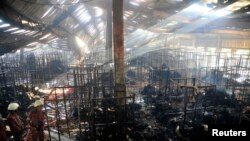NEW DELHI —
In Bangladesh, rescue workers searched for survivors in a burned out garment factory near the capital, Dhaka. At least nine people were killed and about 50 injured in the fire that began Tuesday night. The latest fire will increase pressure on the country to improve safety standards in the garment industry, which has been hit with a string of deadly accidents in the past year.
Firefighters battled into Wednesday against the flames, which originated in the knitting section of a garment factory in Gazipur town on the outskirts of Dhaka.
Fortunately, most workers had left before the blaze swept through the building and a warehouse the previous evening. Out of 170 still working, most managed to escape, but others were not so lucky. Several died, many others sustained injuries. The victims include three managers.
The fire follows a string of deadly accidents in the country’s garment factories. Last November, Bangladesh counted more than 110 victims in another deadly blaze in a garment factory. In April, a building collapse killed 1,100 people.
Following these incidents, the country has come under pressure to improve the dismal safety standards in an industry that supplies many Western brands and is now the world’s second largest apparel manufacturer.
Professor Mustafizur Rahman is director at the Center for Policy Dialogue in Dhaka, a civil society group that has been monitoring the garment industry since the building collapse in April.
Rahman says efforts are under way to tighten inspections, improve buildings and fire safety standards, but he says it will take time for these to have an effect.
“There is a recognition that things can't be as they were going. Entrepreneurs have also designed a number of initiatives," he said. "Some concrete programs have been chalked out. For example, they will examine the structural designs of buildings. We will have to see how faithfully all the programs will be implemented over the next one year.”
Industry experts say Western buyers want to continue doing business in a country whose industry has grown due to the competitive prices it offers.
The garment industry in Bangladesh registered more than 20 percent growth in the July to September quarter.
But accidents like the latest deadly blaze continue to cast a shadow on the industry’s future.
Rahman says there has been no decline in orders in recent months. But he warns that improving safety standards is critical or else Bangladesh runs the risk of business flowing to other Asian countries.
“If there is failure or repetition of big scale disasters etc, then if not in the short term, but in the medium term, two, three years, Vietnam, Myanmar, Cambodia is coming, there can be some significant shift," said Rahman. "But as I said 'til now buyers are interested to work with Bangladesh and I don’t see they have shifted major buying orders.“
The industry earns $20 billion a year from exports and is important for the country. It employs four million workers, mostly women, and accounts for nearly 75 percent of the country’s gross domestic product.
Firefighters battled into Wednesday against the flames, which originated in the knitting section of a garment factory in Gazipur town on the outskirts of Dhaka.
Fortunately, most workers had left before the blaze swept through the building and a warehouse the previous evening. Out of 170 still working, most managed to escape, but others were not so lucky. Several died, many others sustained injuries. The victims include three managers.
The fire follows a string of deadly accidents in the country’s garment factories. Last November, Bangladesh counted more than 110 victims in another deadly blaze in a garment factory. In April, a building collapse killed 1,100 people.
Following these incidents, the country has come under pressure to improve the dismal safety standards in an industry that supplies many Western brands and is now the world’s second largest apparel manufacturer.
Professor Mustafizur Rahman is director at the Center for Policy Dialogue in Dhaka, a civil society group that has been monitoring the garment industry since the building collapse in April.
Rahman says efforts are under way to tighten inspections, improve buildings and fire safety standards, but he says it will take time for these to have an effect.
“There is a recognition that things can't be as they were going. Entrepreneurs have also designed a number of initiatives," he said. "Some concrete programs have been chalked out. For example, they will examine the structural designs of buildings. We will have to see how faithfully all the programs will be implemented over the next one year.”
Industry experts say Western buyers want to continue doing business in a country whose industry has grown due to the competitive prices it offers.
The garment industry in Bangladesh registered more than 20 percent growth in the July to September quarter.
But accidents like the latest deadly blaze continue to cast a shadow on the industry’s future.
Rahman says there has been no decline in orders in recent months. But he warns that improving safety standards is critical or else Bangladesh runs the risk of business flowing to other Asian countries.
“If there is failure or repetition of big scale disasters etc, then if not in the short term, but in the medium term, two, three years, Vietnam, Myanmar, Cambodia is coming, there can be some significant shift," said Rahman. "But as I said 'til now buyers are interested to work with Bangladesh and I don’t see they have shifted major buying orders.“
The industry earns $20 billion a year from exports and is important for the country. It employs four million workers, mostly women, and accounts for nearly 75 percent of the country’s gross domestic product.










